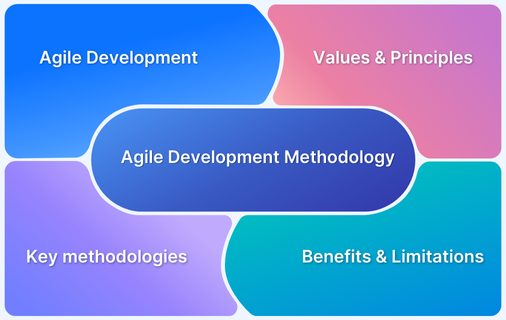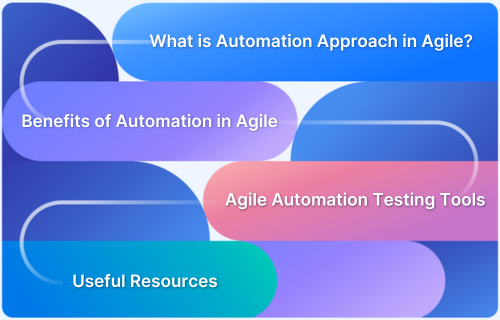Agile methodologies shape how modern software teams build better products, faster.
Overview
What is Agile Development Methodology?
A flexible, iterative approach to software development focused on continuous improvement and customer collaboration.
Importance of Agile Development Methodology
Agile helps teams adapt to changing needs and deliver high-quality software efficiently. It bridges gaps between developers, testers, and customers.
Key Agile Development Methodologies:
- Scrum: Works in short, time-boxed sprints for quick releases.
- Kanban: Visualizes work to improve flow and manage tasks.
- Extreme Programming (XP): Prioritizes code quality through frequent releases.
- Feature-Driven Development (FDD): Builds features in short, incremental cycles.
- Adaptive Software Development (ASD): Adapts continuously to evolving needs.
This article explores what Agile is, why it matters, and how different Agile frameworks can drive better software delivery.
What is Agile Development?
Agile development is a flexible and iterative approach to software development that prioritizes collaboration, customer feedback, and rapid delivery.
Instead of following a strict plan, Agile teams work in short cycles, called sprints, to continuously build, test, and improve products.
This ensures software evolves based on real-world needs, allowing teams to respond quickly to changes and deliver high-quality features.
What is Agile Testing?
Agile testing is a practice that integrates testing activities throughout the entire software development cycle. It ensures that bugs are caught and addressed early, rather than waiting for the end of a project.
Agile testers work closely with developers and stakeholders to provide continuous feedback, improve code quality, and verify that new features meet user needs. This proactive approach helps teams build reliable software quickly and efficiently.
Read More: Debunking Myths about Agile Testing
What is Agile methodology?
Agile development methodologies are project management techniques that involve breaking down projects into smaller, manageable tasks, called sprints. Teams can quickly adapt to changes, gather regular feedback, and deliver higher-quality products in shorter timeframes. For example, teams might release a new feature in one sprint while simultaneously refining existing features based on user feedback from previous sprints.
Role of Agile in Software Testing
Agile plays a crucial role in modern software testing by integrating testing activities throughout development. Instead of testing at the end, Agile promotes continuous testing during each sprint.
This approach:
- Identifies defects early
- Enables faster feedback loops
- Improves collaboration between testers, developers, and stakeholders
- Supports frequent releases and continuous integration
- Ensures testing aligns with evolving user needs
By embedding testing into every stage, Agile ensures that software remains reliable, secure, and user-centric.
Read More: Continuous Testing Strategy in DevOps
Key Agile Methodologies
There are different types of agile methodologies, each with its own approach to managing work, improving collaboration, and delivering high-quality software.
Here’s a quick list of the key Agile Methodologies:
- Scrum
- Extreme Programming (XP)
- Adaptive Software Development (ASD)
- Dynamic Systems Development Method (DSDM)
- Feature-Driven Development (FDD)
- Kanban
- Behavior Driven Development (BDD)
Below is a detailed explanation of what these Agile Methodologies are.
1. Scrum
It focuses primarily on how to handle tasks in a team-based development setting, and it is an agile development methodology. Scrum basically evolved from activities that take place during a rugby round. Scrum promotes operating in small teams and thinks that the development team should be empowered (say- 7 to 9 members). Three roles make up Agile and Scrum, and their duties are described below:
- Scrum Lead: The scrum master is in charge of organizing the team, the sprint meeting, and removing roadblocks.
- Product creator: The product owner builds the product backlog, organizes it by priority, and is in charge of delivering features at each iteration.
- Agile Team: Team coordinates and oversees its own work to finish the sprint or cycle.
Product Backlog in Scrum
The number of requirements (user stories) that need to be finished for each release is tracked in this repository. The Product Owner should keep track of it, prioritize it, and share it with the scrum team. The team may also ask for the addition, modification, or elimination of a new requirement.
Scrum Practices
Scrum methodologies’ workflow:
- A sprint is one iteration of a scrum.
- The list of information needed to produce the final product is called the product backlog.
- The most important user stories from the Product backlog are chosen and added to the Sprint backlog.
- Working together on the specified sprint backlog.
- Team verifies everyday work for accuracy.
- The team provides product functionality at the end of the sprint.
2. Extreme Programming (XP)
The Agile framework for software development processes most closely resembles XP. It strives to build high-quality software while also simplifying the entire process for the development team. XP places a high importance on feedback, communication, simplicity, bravery, and respect.
It works best when,
- The criteria are always shifting.
- Team deadlines are constrained.
- Stakeholders desire to lower risk while meeting timelines.
- Unit and functional testing can be automated by teams.
3. Adaptive Software Development (ASD)
In the first decade of the 1990s, Sam Bayer and Jim Highsmith built adaptive software development (ASD). It comprises the notions of continual adaptation, or how to adopt change rather than avoid it. Learn, collaborate, and speculate is the term of the dynamic growth process that is utilized in ASD. Because the business setting is continuously changing, this process is concentrated on close customer and development engagement and ongoing learning.
ASD offers a non-linear iterative life cycle, in contrast to most software development methodologies, which use a static life cycle, i.e., Plan-Design-Build. Each process can iterate and be altered while another process is being carried out. It suggests rapid application development, which places an emphasis on speed of development to produce a high-quality, low-maintenance product that involves the user as much as possible. The following are the primary traits of ASD:
Speculate:
The major objectives and aims of the project must be established during this phase of its beginning by comprehending the constraints (risk areas) within which it must work. Maintaining coordination between teams during this phase ensures that what is learned by one team is communicated to the others and does not need to be acquired again by other groups from scratch. This phase is where the majority of the development is concentrated.
Learn:
The last stage involves several collaboration cycles, and the goal is to record all of the lessons learnt, both good and bad. The prosperity of the project relies on this stage.
4. Dynamic Software Development Method (DSDM)
A group of specialists and vendors in the sector of software development built the Dynamic Software Development Method in 1994. Software programs with budgets and constrained schedules are the primary priority of DSDM. It accentuates regular product process delivery, and growth is iterative and gradual.
With the Dynamic Software Development Method (DSDM), a roadmap of continuous and early deliveries can be created for the project. This allows for the implementation of an incremental solution, adaptation in response to feedback received along the way, and verification that the anticipated benefits are being realized.
The DSDM is an agile model that may unquestionably assist companies used to operating on projects to alter their mindset and method of operation in order to increase their ability to create value and shorten time to market.
5. Feature Driven Development (FDD)
The key component of this methodology is “designing & creating” features. FDD, in contrast to other Agile development techniques in software engineering, outlines very precise and condensed work phases that must be completed separately for each feature. Domain walkthrough, design review, promotion to build, code review, and design are all included. FDD creates products with the target market in mind.
- Visibility of progress and results
- Regular Builds
- Configuration Management
- Inspections
- Feature Teams
- Component/ Class Ownership
- Development by feature
- Domain object Modeling
6. Kanban
Without adding to the stress of the software development lifecycle, Kanban is a highly visual workflow management technique that enables teams to actively supervise product creation, with a focus on continuous delivery (SDLC). It has gained popularity among groups that use Lean software development techniques.
The three fundamental tenets of Kanban are to visualize the workflow, reduce the amount of work that is in process, and enhance the flow of work. The Kanban technique is intended to aid teams in collaborating more effectively, much like Scrum is. It promotes an atmosphere of active and continuing learning and growth by encouraging continuous collaboration and attempting to establish the ideal process.
7. Behavior Driven Development (BDD)
A behavior-focused agile system development methodology is called behavior driven development (BDD). It was created by Dan North in 2003 as an extension of the TDD methodology. Dan North tried to include non-technical people when creating the system’s technological functionality. Inadvertently leaving out business principles that are already part of the functionality when developing software can occasionally lead to repeated and even serious defects.
BDD uses universal language concepts to facilitate communication inside a software project between persons with and without technical expertise. The BDD development process is built on the writing of test cases and features. These provide the guidelines and requirements for proper system operation. It defines what is necessary for the functionality to start, what will happen next, and what the results will be after it has been completed. Teams who use BDD are better able to communicate needs clearly, find bugs quickly, and create long-lasting software.
4 Values of Agile Software Development
Here are 4 core values of Agile Software Development:
- People and interactions above procedures and equipment.
- Working software is preferred over thorough documentation.
- Collaboration with the customer during contract negotiations
- Following a strategy over reacting to change.
These ideals contribute to the direction of a development procedure that consistently produces high-quality products and satisfies consumers by addressing their wants and adjusting to change more effectively.
12 Principles of Agile Software Development
The Agile methodology is guided by a set of 12 core principles that promote flexibility, collaboration, and efficiency in software development.
Below is a breakdown of the key Agile principles:
1. Customer Satisfaction through Early and Continuous Delivery
Agile prioritizes delivering valuable software to customers early and consistently, ensuring that the final product meets their needs right from the start.
2. Embrace Changing Requirements
Agile teams welcome changes in requirements, even late in the development process, as it allows them to better align the software with evolving business needs.
3. Frequent Delivery of Working Software
Agile focuses on delivering working software often and in small timeframes. This helps the team get regular feedback and make improvements quickly, ensuring the software stays aligned with user needs.
4. Collaboration Between Business and Development Teams
Agile promotes close collaboration between business stakeholders and developers, ensuring that both teams are aligned in achieving common goals.
5. Empower Individuals with the Right Environment and Support
Successful Agile projects are built around motivated individuals. Teams are empowered by being provided with the right environment, resources, and trust to accomplish their tasks.
6. Prioritize Face-to-Face Communication
While digital communication is useful, Agile encourages direct, face-to-face interactions as the most effective way to convey information within a team.
7. Working Software as the Primary Measure of Progress
The primary measure of progress in Agile is the delivery of working software, rather than detailed documentation or lengthy processes.
8. Maintain a Sustainable Development Pace
Agile teams should be able to work at a constant, sustainable pace, allowing them to maintain productivity without burnout.
9. Focus on Technical Excellence and Good Design
Continuous attention to technical excellence and high-quality design enhances agility and enables faster, more efficient software development.
10. Simplicity is Essential
Agile values simplicity, emphasizing maximizing productivity by minimizing unnecessary work and focusing on essential tasks that bring the most value.
11. Encourage Self-Organizing Teams
Agile promotes self-organizing teams that can determine the best approach to design, build, and deliver software, fostering innovation and ownership.
12. Regular Reflection and Adaptation
Agile teams regularly reflect on their processes and performance, making adjustments as needed to improve their effectiveness and outcomes.
Agile Software Development Cycle
The Agile software development cycle is an iterative process designed to foster flexibility, collaboration, and continuous improvement. It consists of these key phases:
- Concept/Planning: Gather requirements, define goals, and prioritize features based on customer needs.
- Design: Create a flexible design or framework outlining how the product will function.
- Development: Build the product in small, incremental sprints that deliver working software.
- Testing: Continuously test each sprint to identify bugs and ensure functionality meets expectations.
- Deployment: Release working software to users and collect feedback as part of continuous delivery.
- Feedback/Review: Collect input from customers and stakeholders to refine future iterations.
- Iteration: Use feedback to improve the product and repeat the cycle until the software meets quality standards and customer needs.
Example of Agile Software Development
Imagine a team building a mobile banking app.
They work in two-week cycles (sprints), creating small features like login screens or balance displays. After each cycle, they test these features, get feedback from real users, and quickly adjust based on that feedback.
This keeps the project on track and ensures the app meets user needs.
Benefits of Agile Software Development
Agile Software Development methodologies are increasingly popular among leaders and developers for several compelling reasons:
- Enhanced Collaboration: Agile fosters strong collaboration between development teams and clients, resulting in greater clarity and satisfaction.
- Higher Product Quality: Regular testing allows for early issue detection, leading to higher-quality, well-tested products.
- Flexibility to Change: Agile enables teams to quickly adapt to shifting client needs and market changes, ensuring timely delivery of relevant products.
- Lower Risk and Faster ROI: Frequent reviews reduce risks, allowing teams to pivot quickly if issues arise. Agile’s focus on client feedback ensures decisions enhance product value.
- Continuous Improvement: Agile emphasizes iterative development and regular retrospectives, allowing teams to learn from each cycle and improve processes continuously.
- Customer-Centric Focus: By involving customers throughout the development process, Agile ensures that the final product aligns closely with user needs and expectations, leading to increased customer satisfaction
Limitations of Agile Software Development
While Agile offers many benefits, it also presents some challenges that teams need to consider.
- Difficulty in Estimation: Estimating effort for large projects can be challenging in Agile, leading to uncertainties in timelines and resource allocation.
- Reduced Documentation: The focus on working software may result in less documentation, creating information gaps that can lead to misunderstandings.
- Customer Dependence: Agile’s need for customer feedback means that unclear input can misguide the project, leading to products that may not effectively meet user needs.
- Unpredictability: Regular changes and constant feedback can make it hard to predict how long a project will take or how much it will cost, which can lead to adding more work than planned.
- Burnout Risk: The fast-paced nature of Agile can lead to team burnout if adequate breaks and support are not provided, impacting morale and productivity.
Why Choose Agile Software Development?
Agile Software Development is a popular method because it helps teams deliver software quickly and adapt to changes easily. It focuses on working closely with customers to get their feedback, ensuring the final product meets their needs. Agile also encourages regular testing, which leads to better quality software.
Moreover, it promotes teamwork and allows team members to take charge of their work. This approach reduces risks and makes the development process more predictable, making it a great choice for many companies.
Conclusion
While developing a software, testers need to ensure that agile testing is done across multiple UIs, browsers and devices. BrowserStack Live lets you do interactive testing across different platforms and browsers.
Increasingly, more organizations are adopting Agile methodologies to embrace more efficiency and structure in their cross-team collaborations as the conventional software development methods are running out of market. You might want to check out the highly-efficient and conversant platforms of BrowserStack viz. Percy, Automate and Live to overcome any Agile software development challenges.
While your organization adopts Agile, BrowserStack Live for Teams might be a very efficient platform to let your team access cross browser testing and access 3500+ real desktop.
Useful Resources for Agile Methodologies
- Agile Development Methodologies: An Essential Guide
- All about Agile SDLC (Software Development Life Cycle)
- What is Agile Testing Know About Its Life Cycle, Types, and Metrics
- What is Agile Testing Quadrants: Why & How to Use It
- What is a Test Plan in Agile?
- How to Write Software Requirement Specifications in Agile
- Agile Testing Metrics that Every Tester Must Know
- 11 Agile Testing Challenges and its Solutions
- Debunking Myths about Agile Testing
- How BDD and Agile Together Make Testing Efficient
- Continuous Integration in Agile
- What does continuous delivery mean in agile?
- Risk Based Testing Approach for Agile Teams
- How to run Regression Testing in Agile Teams
- Role and Responsibilities of QA managers in Agile organizations
- Agile vs DevOps: What’s the Difference?
- Difference between CI and CD, Agile and DevOps
- Why Automation Testing is at the Centre of Agile Development






